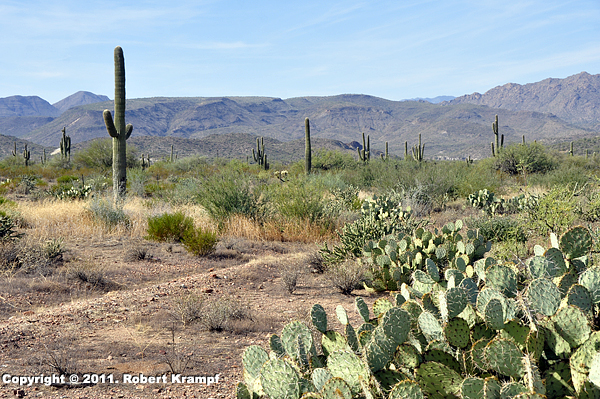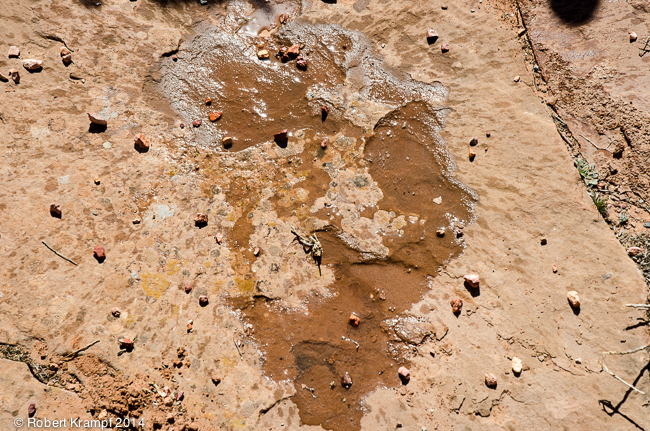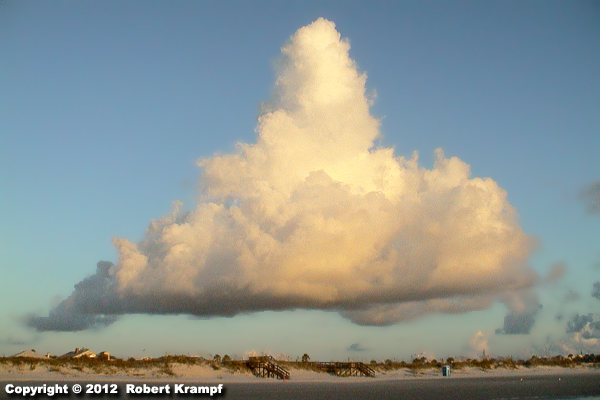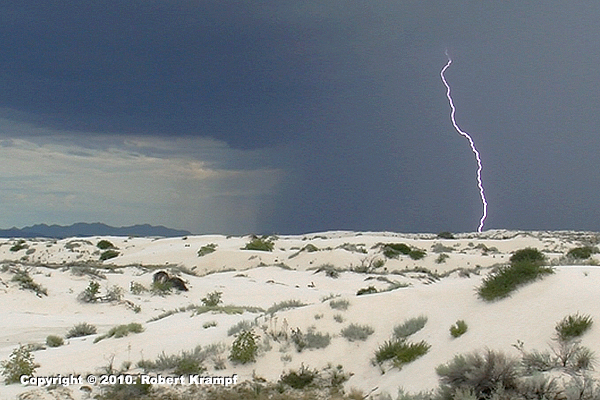Here are some science questions to help you test your knowledge of the Next Generation Sunshine State Standards.
The questions are chosen randomly, so this quest will be different each time you reload the page.
Back to the Grade 5 standards.

How hot does an area have to be to be classified as a desert?
Answer:
Deserts are defined by lack of precipitation, not by temperature. They are areas where precipitation minus evaporation yields less than 10 inches of rain per year. The largest desert on Earth is in Antarctica, a very cold place.
Click to see which state standards this question tests, and which of my videos, experiments, and other resources support that topic.
Florida
SC.5.E.7.6 Describe characteristics (temperature and precipitation) of different climate zones as they relate to latitude, elevation, and proximity to bodies of water.
| Weather and Climate | video |
| Review Weather-7 | practice |
| Review Weather-9 | practice |
Utah
UT.4.V.1.c Locate examples of areas that have characteristics of wetlands, forests, or deserts in Utah.
| Review Weather-7 | practice |
| Review Weather-9 | practice |
NGSS

I poured some water on this rock. Later that day, the water was all gone. What happened to it?
-
It evaporated.
Yes. When liquid water turns into water vapor, the process is called evaporation. That is what happened to the water on the rock. -
It sublimated.
No. Sublimation is when a solid turns directly into a gas. Dry ice (frozen carbon dioxide) is an example of sublimation. The solid changes directly into carbon dioxide gas, without becoming a liquid. -
It condensed.
No. Condensation is when a gas turns into a liquid. The drops of water that form on the outside of a glass of ice is the result of condensation. -
It precipitated.
No. In weather, precipitation is when solid or liquid water falls from the clouds. Rain, snow, and sleet are examples of precipitation.
Click to see which state standards this question tests, and which of my videos, experiments, and other resources support that topic.
Florida
SC.3.P.9.1 Describe the changes water undergoes when it changes state through heating and cooling by using familiar scientific terms such as melting, freezing, boiling, evaporation, and condensation.
| Cloud Formation, part 1 | video, ClosedCaptions, checked |
| The Water Cycle | video, checked |
| A Model of the Water Cycle | video, ClosedCaptions, checked |
| Cloud Formation, part 2 | video |
| Making a Solar Still | video |
| Wonderful Water | video, checked |
| A Watched Pot | video |
| Why We Sweat | video, checked |
| Photographing Snowflakes | video, checked |
| Ice Cream Science | video, checked |
| What Really Happens With Evaporation? | text page, free, checked |
| Review Weather-1 | practice |
| Review Weather-2 | practice |
| Review Weather-10 | practice |
SC.5.E.7.1 Create a model to explain the parts of the water cycle. Water can be a gas, a liquid, or a solid and can go back and forth from one state to another.
>>> Teacher Page: Water Cycle
| Cloud Formation, part 2 | video |
| Cloud Types | video |
| Making a Solar Still | video |
| A Watched Pot | video |
| Photographing Snowflakes | video, checked |
| The Water Cycle | video, checked |
| A Model of the Water Cycle | video, ClosedCaptions, checked |
| Review Weather-8 | practice |
| Review Weather-10 | practice |
| Review Weather-1 | practice |
| Review Weather-2 | practice |
Utah
UT.4.I.2.a Locate examples of evaporation and condensation in the water cycle (e.g., water evaporates when heated and clouds or dew forms when vapor is cooled).
| Cloud Types | video |
| Making a Solar Still | video |
| A Watched Pot | video |
| Cloud Formation, part 1 | video, ClosedCaptions, checked |
| The Water Cycle | video, checked |
| A Model of the Water Cycle | video, ClosedCaptions, checked |
| A Cool Experiment | text page |
| Review Weather-2 | practice |
| Review Weather-1 | practice |
NGSS
MS-ESS2-5 Collect data to provide evidence for how the motions and complex interactions of air masses results in changes in weather conditions.
| Cloud Types | video |
| Nephoscope | video, checked |
| Cloud Formation, part 1 | video, ClosedCaptions, checked |
| Pine Cone Weather | text page, free |
| Review Weather-1 | practice |
| Review Weather-2 | practice |
| Review Weather-6 | practice |
| Review Weather-4 | practice |
| Review Weather-3 | practice |

Which of these processes forms the VISIBLE part of a cloud?
-
Evaporation
No. Evaporation changes liquid water into water vapor. Water vapor is an invisible gas, so it is not the visible part of the cloud. -
Condensation
Yes! Condensation changes water vapor into droplets of liquid water to form the cloud. These are just like the tiny water droplets that form fog, letting you see the cloud. -
Precipitation
No. Precipitation can fall from a cloud, but it is not the process that forms the cloud. -
Convection
No. Convection carries the water vapor upwards so it can cool and condense, but condensation is what forms the visible part of the cloud.
Click to see which state standards this question tests, and which of my videos, experiments, and other resources support that topic.
Florida
SC.3.P.9.1 Describe the changes water undergoes when it changes state through heating and cooling by using familiar scientific terms such as melting, freezing, boiling, evaporation, and condensation.
| Cloud Formation, part 1 | video, ClosedCaptions, checked |
| The Water Cycle | video, checked |
| A Model of the Water Cycle | video, ClosedCaptions, checked |
| Cloud Formation, part 2 | video |
| Making a Solar Still | video |
| Wonderful Water | video, checked |
| A Watched Pot | video |
| Why We Sweat | video, checked |
| Photographing Snowflakes | video, checked |
| Ice Cream Science | video, checked |
| What Really Happens With Evaporation? | text page, free, checked |
| Review Weather-1 | practice |
| Review Weather-2 | practice |
| Review Weather-10 | practice |
SC.5.E.7.1 Create a model to explain the parts of the water cycle. Water can be a gas, a liquid, or a solid and can go back and forth from one state to another.
>>> Teacher Page: Water Cycle
| Cloud Formation, part 2 | video |
| Cloud Types | video |
| Making a Solar Still | video |
| A Watched Pot | video |
| Photographing Snowflakes | video, checked |
| The Water Cycle | video, checked |
| A Model of the Water Cycle | video, ClosedCaptions, checked |
| Review Weather-8 | practice |
| Review Weather-10 | practice |
| Review Weather-1 | practice |
| Review Weather-2 | practice |
Utah
UT.4.I.2.a Locate examples of evaporation and condensation in the water cycle (e.g., water evaporates when heated and clouds or dew forms when vapor is cooled).
| Cloud Types | video |
| Making a Solar Still | video |
| A Watched Pot | video |
| Cloud Formation, part 1 | video, ClosedCaptions, checked |
| The Water Cycle | video, checked |
| A Model of the Water Cycle | video, ClosedCaptions, checked |
| A Cool Experiment | text page |
| Review Weather-2 | practice |
| Review Weather-1 | practice |
NGSS
MS-ESS2-5 Collect data to provide evidence for how the motions and complex interactions of air masses results in changes in weather conditions.
| Cloud Types | video |
| Nephoscope | video, checked |
| Cloud Formation, part 1 | video, ClosedCaptions, checked |
| Pine Cone Weather | text page, free |
| Review Weather-1 | practice |
| Review Weather-2 | practice |
| Review Weather-6 | practice |
| Review Weather-4 | practice |
| Review Weather-3 | practice |
Which of the following forms of ice commonly occurs in the summer when air temperatures are well above freezing?

A: Hail

B: Snow

C: Frost

D: Freezing rain
Think about it, and when you think you know the answer, then click here.
While other kinds of frozen precipitation can form at high altitudes, in the summer they usually melt long before they reach the ground. Hail is made up of large enough chunks of ice that it usually remains frozen all the way to the ground, even during warm weather.
Click to see which state standards this question tests, and which of my videos, experiments, and other resources support that topic.
Florida
SC.5.E.7.4 Distinguish among the various forms of precipitation (rain, snow, sleet, and hail), making connections to the weather in a particular place and time.
| Photographing Snowflakes | video, checked |
| Building a Rain Gauge, part 2 | video, checked |
| Building a Rain Gauge, part 1 | video, checked |
| Snow Rollers | text page |
| Review Weather-6 | practice |
| Review Weather-3 | practice |
Utah
UT.4.II.2.a Observe and record effects of air temperature on precipitation (e.g., below freezing results in snow, above freezing results in rain).
| Photographing Snowflakes | video, checked |
| Building a Rain Gauge, part 2 | video, checked |
| Building a Rain Gauge, part 1 | video, checked |
| Review Weather-6 | practice |
| Review Weather-3 | practice |
NGSS
3-ESS2-1 Represent data in tables and graphical displays to describe typical weather conditions expected during a particular season.
| Nephoscope | video, checked |
| Pine Cone Weather | text page, free |
| Review Weather-5 | practice |
| Review Weather-6 | practice |
| Review Weather-4 | practice |
| Review Weather-3 | practice |
| Review Space-5 | practice |
| Review Space-8 | practice |
MS-ESS2-5 Collect data to provide evidence for how the motions and complex interactions of air masses results in changes in weather conditions.
| Cloud Types | video |
| Nephoscope | video, checked |
| Cloud Formation, part 1 | video, ClosedCaptions, checked |
| Pine Cone Weather | text page, free |
| Review Weather-1 | practice |
| Review Weather-2 | practice |
| Review Weather-6 | practice |
| Review Weather-4 | practice |
| Review Weather-3 | practice |

How can there be rain if this area is a desert?
Answer:
It is important to understand the difference between climate and weather. Weather is what is happening now. Climate is determined by looking at the weather data over a long period of time, often several decades. To be classified as a desert climate, the area has an average annual rainfall of 7.87 inches of rain or less. That tells us that it does sometimes have rain, just not very often.
Click to see which state standards this question tests, and which of my videos, experiments, and other resources support that topic.
Florida
SC.2.L.17.2 Recognize and explain that living things are found all over Earth, but each is only able to live in habitats that meet its basic needs.
| Hunting with an Umbrella | video, free, ClosedCaptions, Updated |
| A Walk in the Park | video, checked |
| Review Weather-9 | practice |
SC.5.E.7.6 Describe characteristics (temperature and precipitation) of different climate zones as they relate to latitude, elevation, and proximity to bodies of water.
| Weather and Climate | video |
| Review Weather-7 | practice |
| Review Weather-9 | practice |
SC.6.E.7.2 Investigate and apply how the cycling of water between the atmosphere and hydrosphere has an effect on weather patterns and climate.
| Cloud Types | video |
| Nephoscope | video, checked |
| The Water Cycle | video, checked |
| Weather and Climate | video |
| Pine Cone Weather | text page, free |
| Review Weather-8 | practice |
| Review Weather-9 | practice |
| Review Weather-10 | practice |
SC.6.E.7.6 Differentiate between weather and climate.
| Weather and Climate | video |
| Review Weather-9 | practice |
Utah
UT.4.V.1.a Compare the physical characteristics (e.g., precipitation, temperature, and surface terrain) of Utah's wetlands, forests, and deserts.
| Weather and Climate | video |
| Review Weather-9 | practice |
UT.4.V.1.c Locate examples of areas that have characteristics of wetlands, forests, or deserts in Utah.
| Review Weather-7 | practice |
| Review Weather-9 | practice |
NGSS
MS-ESS2-6 Develop and use a model to describe how unequal heating and rotation of the Earth cause patterns of atmospheric and oceanic circulation that determine regional climates.
| Cloud Formation, part 2 | video |
| Global Science | video, ClosedCaptions |
| Weather and Climate | video |
| Review Weather-9 | practice |
3-ESS2-2 Obtain and combine information to describe climates in different regions of the world.
| Weather and Climate | video |
| Review Weather-9 | practice |
The questions are chosen randomly, so this quest will be different each time you reload the page.
Non-subscriber
